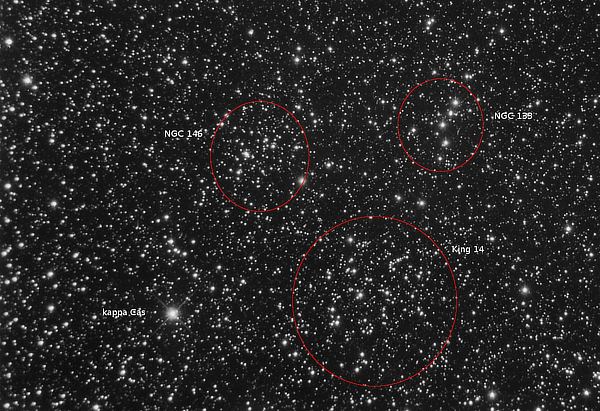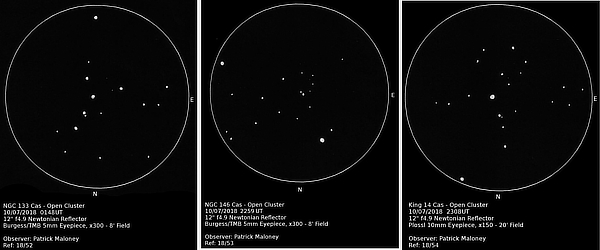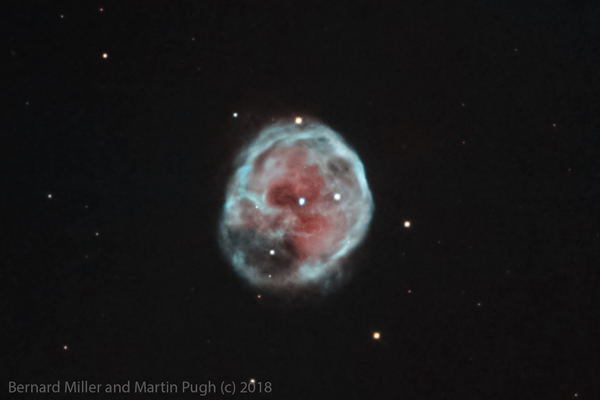Open clusters in Cassiopeia and a planetary nebula in Cetus
October 2021 - Nebula and Cluster of the Month
This month, we’ll be looking at a group of three open clusters which have been considered as a genuine cluster triplet, and a slightly challenging planetary nebula.
High in the northern October sky stands the familiar ‘wonky wubbledoo’ of Cassiopeia. Straddling the Milky Way, Cassiopeia is rich in open clusters, many of which form a near-continuous band across the top of the familiar ‘W’ asterism.
Three of these clusters form a triangle, 12’ to a side, just 15’ north-northwest of the magnitude 4.1 star kappa Cas. The three clusters are NGC 133, NGC 146 and King 14. It has to be said from the start that none of these objects is visually stunning, but they have an interesting story to tell.

The first to be discovered was NGC 146, by John Herschel in 1829. At the time, he described it as A loose cluster; stars magnitude 11 and 12, 10’ diameter
, a description that remained intact through to the 1888 NGC. He also added that the position he gives is that of the double star h1033 which is a member of the cluster.
Through the telescope, NGC 146 is distinctly underwhelming. My own observation states that if I hadn’t known it was there, I would have completely overlooked it. It (just about) reveals itself as a loose scatter of 11th and 12th magnitude stars between three brighter stars that make up a long, narrow triangle. The double star mentioned by Herschel comprises two 11th mag stars separated by about 6.5”.
The Trumpler classification for NGC 146 is II2p (detached with little central condensation, medium range of stellar brightnesses, poor (fewer than 50 stars)). Although this classification is given by Archinal & Hynes, they also give its population as 132 stars. There is a background scatter of stars of magnitude 15 to 17, and it’s presumably these that make up the numbers.
NGC 133 was discovered in 1865 by Heinrich d’Arrest. Its classification is given by Archinal & Hynes as IV1p (not well detached, stars all of similar brightness, poor). Despite the ‘not well detached’ classification, this object is much easier to discern than NGC 146. It consists of only seven to ten stars (five, according to A&H), all of which are considerably brighter than the background stars. The stars form a distinctive ‘Y’-shape. The central star in the downstroke of the ‘Y’ is a double, magnitudes about 11.1 and 11.7, separation a little bit less than a minute.

The third object in the trio is King 14, which wasn’t identified as a cluster until the mid-twentieth century, and yet oddly is possibly the most impressive-looking of all of them. It forms a visually coherent group; loose but recognisable as a cluster.
In 2006, a paper by Netopil, Maitzen, Pauzen and Claret appeared in Astronomy & Astrophysics, entitled ‘Photometric Survey of marginally investigated open clusters: I. Basel 11b, King 14, Czernik 43’. In the paper, it is mentioned that King 14, along with NGC 133 and NGC 146 form an apparent triplet
, with the proviso that NGC 133 is closer to us than the other two.
A further paper by Kopchev, Nedialkov and Petrov (Comptes Rendues de l’Academie Bulgare des Sciences 2005, 58, 12, 1363), entitled ‘Age Determinations of the Open Clusters King 14 and NGC 146’ concluded that King 14 is 63 ± 8 million years old whereas NGC 146 is only 32 ± 8 million years old. They also quote distances of 2593pc for King 14 and 3032pc for NGC 146, separating them by over 1400 light-years.
Clearly then, NGC 146 and King 14 are not physically associated. What then of NGC 133? I have conducted my own, far more modest, investigation into this object. The main stars seem to be in isolation, there is no concentration of fainter stars amongst them, suggesting that the seven or eight, or however many you count, are all that there are. A quick look at these stars’ proper motions shows that none of them are moving in the same direction or at the same speed, as any other. The proper motion scatter reveals NGC 133 to be an asterism and not a true cluster.
The ‘triplet’ of open clusters therefore turns out to be nothing at all.
Our nebula of the month is NGC 246, a large planetary nebula in Cetus. NGC 246 lies in a relatively blank area of sky at the rear-end of Cetus, about 6° north of second-magnitude β Ceti. This can be a challenging object for light-polluted British observers, being at a declination of -12°.
It was discovered by William Herschel on 27th November 1785. He described it as Four or five pretty large stars forming a trapezium of about 5’ diameter. The inclosed space is filled up with faintly terminated milky nebulosity. The stars seem to have no connexion with the nebulosity.

The planetary nebula lies around 1600 light-years distant. The apparent diameter is around 4.5’, which would mean that if the distance is correct, the nebula is about two light-years in diameter. Its combined visual magnitude is 10.9, but this is spread over a relatively large area, making it quite a dim object.
I observed it from a dark-sky site a few years ago, and the impression of a ghostly, screaming head is hard to ignore. Visually, two stars represent the head’s eyes, but on deeper images, two further dark areas can be detected, giving the whole thing the appearance of a human skull. My ‘ghost head’ is largely visual and tends to be lost in deeper images.

My 2014 observation reads as follows: Very large but pretty faint. Although this planetary nebula has a magnitude of 10.9, it appears very dim because of its low altitude (24 degrees at the time of observation). Three stars were seen to be involved. It appears as an oval disc, elongated roughly N-S with uncertain edges. A darker patch could be seen near the middle. The nebula was barely visible without the OIII filter, the stars were barely visible with.
Patrick Maloney (DeepSkyBagger@gmail.com)
| Object | RA | Dec | Type | Magnitude |
|---|---|---|---|---|
| NGC 133 | 00h 31m 20s | +63° 20’ 05” | Asterism | 9.4 |
| King 14 | 00h 31m 53s | +63° 09’ 10” | Open cluster | Br * 10.0 |
| NGC 146 | 00h 33m 04s | +63° 17’ 48” | Open cluster | 9.1 |
| NGC 246 | 00h 47m 45s | -11° 59’ 13” | Planetary nebula | 10.9 |